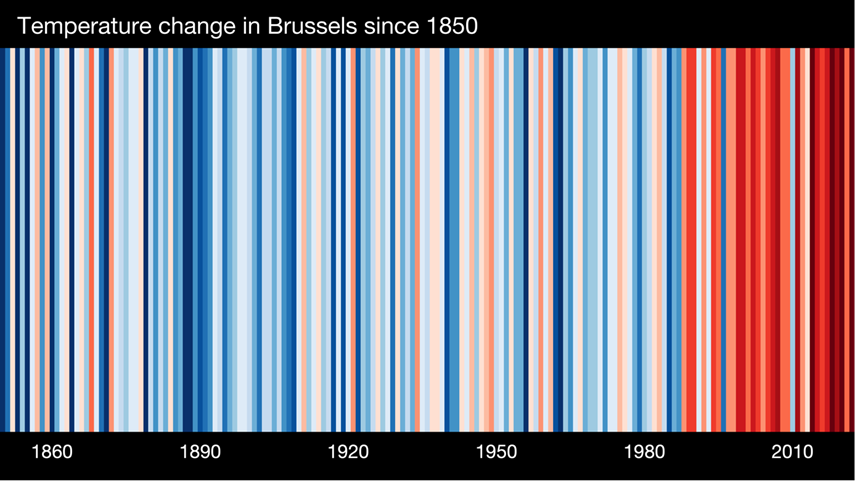Yanaika obtained an Msc in Bioscience engineering with a focus on Environmental Technology. She then deepened her knowledge on climate change through a second Msc in Carbon Management at the University of Edinburgh.
Climate Communication: Show Your Stripes, Then Inspire
Last week, on June 21st, it was #ShowYourStripes day, an occasion where people all over the world shared the remarkable evolution of their country's average yearly temperature. The power of these visuals is undeniable, delivering a resounding message: our world is growing warmer.

The graph and the #ShowYourStripes-initiative serve as powerful tools of communication, raising awareness about climate change. However, scientists have identified an issue known as the “knowledge-action” gap. Initially, it was assumed that by informing people about climate change and by raising awareness, necessary actions to address the crisis would naturally follow. Unfortunately, this assumption has proven to be untrue. Over 78% of Europeans believe climate change to be a very serious problem and this number even rises to 82% for Belgium[1]. The same survey finds that the number of respondents that have undertaken climate action drops to 64% for the EU and 62% Belgium. On the Climate Change Performance Index[2], Belgium ranks 40th, alongside countries like Brazil and Vietnam.
As research points out, mere climate awareness does not necessarily translate to climate action, and on itself information on the climate issue is insufficient to drive behavioral change. Climate change, it turns out, is a very tricky subject to communicate about. In part, this is because the topic of climate change encounters a range of psychological barriers. For instance, messages that are filled with doom and gloom can evoke feelings of paralyzing hopelessness. Additionally, the impacts of climate change often feel distant, both in terms of space and time, which further disconnects individuals from taking immediate action.
How Can We Close the Knowledge-Action Gap?
Being aware of these challenges and addressing them can indeed improve the impact of climate communications. There’s a range of recommended ways to go about climate communication:
- Make the topic relatable yet urgent, allowing the individuals to feel a personal connection to the issue
- Understand that there is a diversity within your audiences and tailor your message to your specific audience
- Shift the focus from solely providing information to also highlighting practical solutions
- Demonstrate that climate action is feasible by showing tangible, real-world and achievable solutions[3]
- Communicate at a level that resonates with people’s values and emotions
An interesting way to approach this is through storytelling, which allows you to captivate the audience and break down a complex topic more easily.
How is this linked to the #ShowYourStripes initiative? Well, the powerful visual representation is a strong way to grab the attention of an audience. As such, it provides the perfect opportunity to close the knowledge-action gap by going one step further and inspiring your audience to act. Perhaps you recently took a climate-conscious action, such as shifting your diet or buying an electric car, or perhaps you are working on a project at work that lowers carbon emissions. It could be that you just read an interesting article about a climate solution, or you can inspire people through art. Raise awareness, and while you are at it, inspire change.
___________________________________________________
[1] https://europa.eu/eurobarometer/surveys/detail/2273
[2] https://ccpi.org
[3] If you’re looking for inspiration Econopolis’s Geert Noels, Kristof Eggermont and myself published the book “De Klimaatschok” or “Le Choc Climatique” that discusses 20 climate solutions for Belgium, inspired by Paul Hawken’s “Drawdown”.
